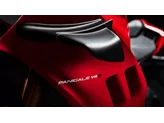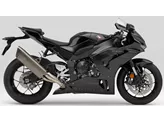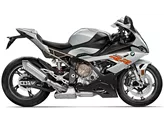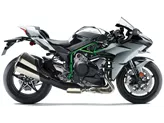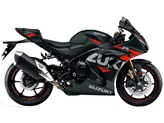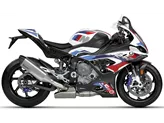BMW F 800 R 2017 vs. BMW S 1000 RR 2015

BMW F 800 R 2017

BMW S 1000 RR 2015
Overview - BMW F 800 R 2017 vs BMW S 1000 RR 2015
The BMW F 800 R 2017 and the BMW S 1000 RR 2015 are both impressive motorcycles, but they cater to different riding styles and preferences.
Starting with the BMW F 800 R 2017, it is a naked bike with a 798cc in-line engine. It produces 90 horsepower and 86 Nm of torque, making it a capable machine for everyday riding. The engine has a compression ratio of 12.02 and features a 2-cylinder configuration. The F 800 R has a lightweight aluminum frame, specifically a Twin Tube load-bearing engine frame, which contributes to its low weight. The front suspension consists of an upside-down telescopic fork, while the rear suspension is a swing arm. The braking system includes double disc brakes with four pistons and radial technology. The bike has a front tire width of 120mm and a rear tire width of 180mm, both with a diameter of 17 inches. The wheelbase measures at 1520mm, and the seat height is adjustable between 790mm and 820mm. The fuel tank capacity is 15 liters.

BMW F 800 R 2017
The BMW F 800 R 2017 has several strengths. Firstly, it boasts strong brakes, ensuring reliable stopping power. Additionally, it comes with upgraded equipment, enhancing the overall riding experience. Its low weight makes it agile and easy to handle. The accessible geometry of the bike allows for a comfortable riding position. Lastly, the F 800 R has a characteristic sound, adding to the overall appeal of the motorcycle. However, it does have some weaknesses. It can be seen as somewhat pragmatic, lacking some of the excitement and flair found in other models. The effervescence of the bike is a little lacking, which may not appeal to riders seeking a more exhilarating experience.
On the other hand, the BMW S 1000 RR 2015 is a supersport bike with a 999cc in-line engine. It delivers an impressive 199 horsepower and 113 Nm of torque, making it a highly powerful machine. The engine has a compression ratio of 13 and features a 4-cylinder configuration. Similar to the F 800 R, it has an aluminum frame, specifically a Twin Tube frame. The front suspension consists of a telescopic fork, while the rear suspension is a swing arm. The braking system includes double disc brakes with four pistons and radial technology. The front tire width is 120mm, and the rear tire width is 190mm, both with a diameter of 17 inches. The wheelbase measures at 1425mm, and the seat height is 815mm. The fuel tank capacity is 17.5 liters.

BMW S 1000 RR 2015
The BMW S 1000 RR 2015 has several strengths. It features a superb shift assistant, allowing for smooth and precise gear changes. The engine is incredibly powerful and rev-happy, providing an exhilarating riding experience. The bike also offers a great range of accessories, allowing riders to customize and enhance their bike to their liking. Additionally, it comes with a race-ready data logging tool and calibration tool, which can be useful for track enthusiasts. However, it does have a weakness. The chassis of the S 1000 RR can quickly reach its limit in the hands of professional riders, potentially limiting its performance in high-speed and aggressive riding scenarios.
In conclusion, the BMW F 800 R 2017 and the BMW S 1000 RR 2015 are both impressive motorcycles, but they cater to different riding styles and preferences. The F 800 R is a capable and practical naked bike, while the S 1000 RR is a high-performance supersport machine. Riders looking for a versatile and comfortable everyday bike may prefer the F 800 R, while those seeking adrenaline and track-ready performance may lean towards the S 1000 RR.
Technical Specifications BMW F 800 R 2017 compared to BMW S 1000 RR 2015
Pros and Cons in comparison
Pros and Cons in comparison
BMW F 800 R 2017

With a EURO4 engine, new riding modes, new instruments and new colours, the F 800 R starts the new season. It is recognisable at first glance only by the end cap on the stately stainless steel exhaust. It is one of those full-grown motorbikes that, despite its considerable sporting potential, was designed for the widest possible user group. Therefore, it is absolutely beginner-friendly (throttled), but can also inspire an experienced audience. Its character remains somewhat pragmatic, but the unmistakable, hollow sound of the inline two compensates for this.
BMW S 1000 RR 2015

The BMW can still score points with hard facts in 2015. If you like top performance, you have to buy the BMW. It turns out incredibly powerful at the top and drives away the rest of the field from 200. Big and heavy riders will be able to benefit from this even more. BMW didn't make it easy for themselves with this bike and put together a very universal motorbike. If you were to do a comparison test with 50 different riders (from rookie to pro), the BMW would have the best average of all 1000cc bikes. The electronic chassis, but also the riding aids, make the pros fast and the beginners safe on the road. A top recommendation for a very broad target group. Very fast hobby riders will not be 100% satisfied with the standard suspension. If you don't want to modify the chassis, you should rather go for an R1M, a Panigale S or an RSV RF. If you want to convert anyway, the S 1000 RR is the strongest and most universal base. Surprisingly, the powerful machine also rides very well on country roads. All in all, it looks like a compromise, but it never feels like one in practice.
Price Comparison Avarage Market Price BMW F 800 R vs BMW S 1000 RR
There are a few key differences between a BMW F 800 R 2017 and a BMW S 1000 RR 2015. In terms of price, the actual average price of a BMW S 1000 RR 2015 is about 98% higher. Compared to BMW S 1000 RR 2015 there are more BMW F 800 R 2017 bikes available on the 1000PS.de Marketplace, specifically 16 compared to 8. It takes less time to sell a BMW S 1000 RR with 77 days compared to 105 days for the BMW F 800 R. Since model year 2009 1000PS.de editors have written 20 reviews for the BMW F 800 R and 135 reviews for the BMW S 1000 RR since model year 2010. The first review for the BMW F 800 R was published on 10/10/2008 and now has more than 8,900 views. This compares to more than 4,000 views for the first review on BMW S 1000 RR published on 4/16/2008.


